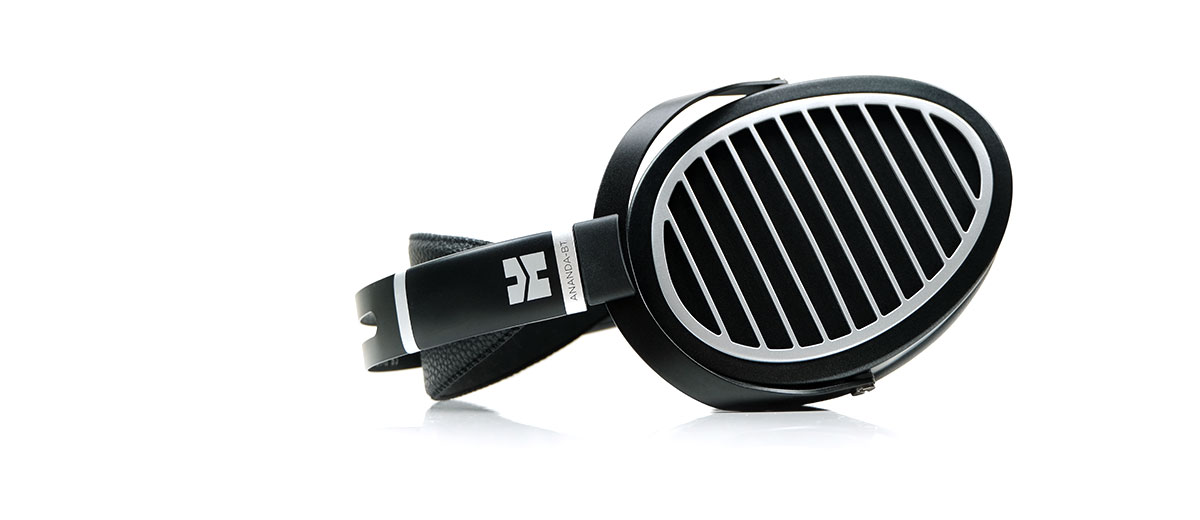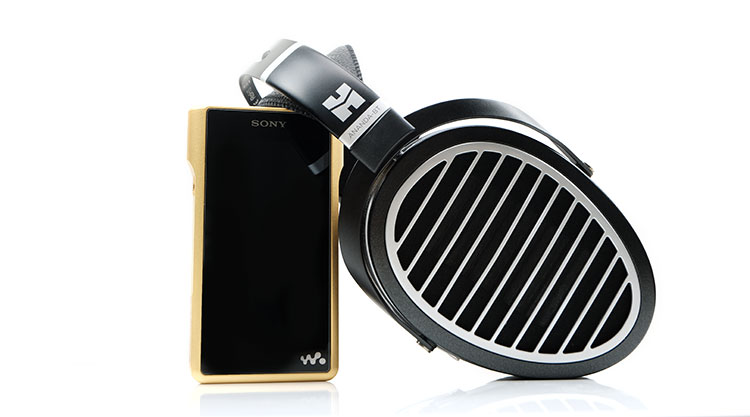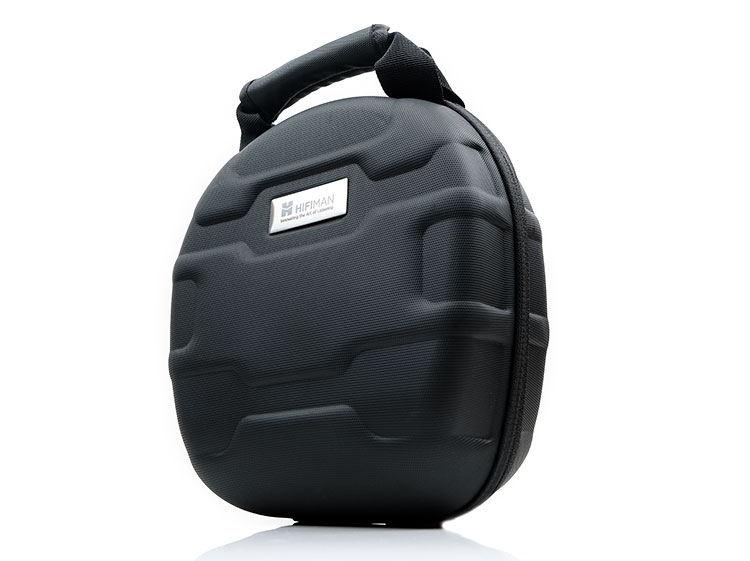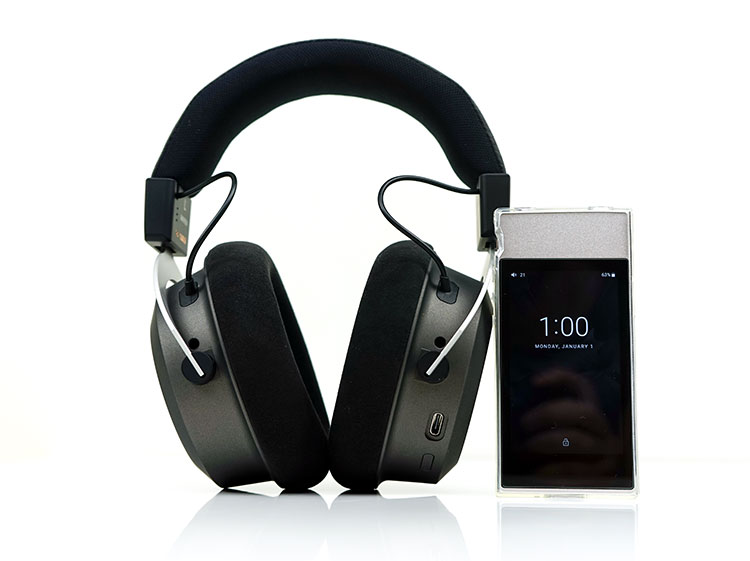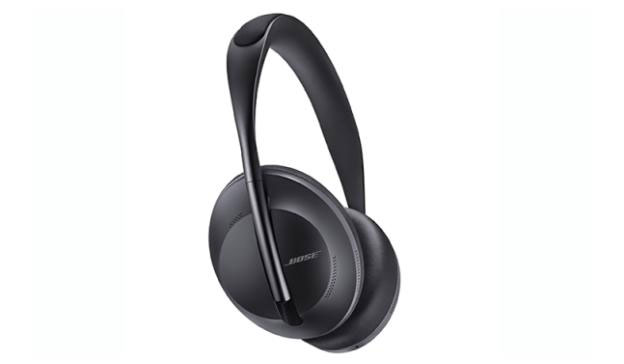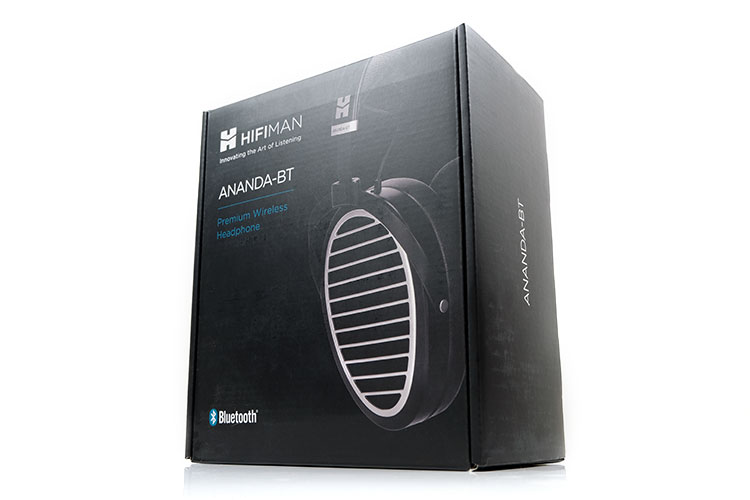Sound Impressions
Summary
Let’s go with the headline summary. The Ananda BT is the best-sounding Bluetooth headphone I have heard, period. It edges out the high-end beyerdynamic Amiron Wireless and slays the consumer Sony and Bose flagship BT headphone equivalents.
Much of that has to do with the quality of that excellent planar driver inside including the open-back design. The rest is down to the amplification topology inside to drive it combined with the LDAC/HWA codec decoding ceiling.
However, it is not an exact duplicate of the original Ananda analog version. This might be a preference thing but the Ananda BT is fuller sounding with a heftier low-end and a bit more meat on the bones of that midrange instrumental timbre.
However, it trades in a little tightness and speed as a result and I do find the original Ananda to be the cleaner and more controlled of the two headphones.
In short, the Ananda original is more neutral in terms of tuning and instrumental positioning and sounds the wider and airier of the two signatures. I would classify the analog headphones to be closer to a reference sound than the wireless version.
The Ananda BT is more intimate and forward in its staging but also more powerful sounding, especially in vocal presence.
Staging
The Ananda BT has a bit more low-end power than the original because of the slight change in positioning and elevation across the FR compared to the original. I thought the original was quite linear with a slight low-end fade sub-200Hz that does not seem to be the case with the BT version.
The low-end is much more forward sounding and as a result, everything sub-800Hz sounds a bit closer. To be honest, that theme carries across the whole FR so the staging is not as neutral as the original. I would also say it is not quite as airy though depth-wise it is deeper.
The top-end has some excellent extension and is way better than any wireless headphone I can think of right now without it sounding unnatural but again, it is closer sounding than the original. The original is more extended but also more neutral and lighter in body. That lighter and yes, quicker sound, produces a more ethereal quality to the Ananda’s top-end.
Bass
The Ananda BT low-end is very different now to the original and one which I enjoy. It is punchier, more physical, a little warmer, and has less of a roll-off sub-200Hz. I would argue right now the Ananda BT low-end is simply better, especially if you enjoy modern music that requires a healthy level of PRaT.
I would still not define the low-end as aggressive or physical but the weighting has a better balance about it and does help deliver a more satisfying fundamental to lower-pitching instruments and bass synth or electronic drum beats.
They sound far more planted, especially modern R’n’B, synth, and rock, and that helps deliver a much more musical tone to Ananda BT’s performance.
Crucially, it is not bloomy or soft sounding. I keep forgetting at times this is a wireless experience. Compared to the veiled smear of the Sony WH-1000XM3 or the softer warmth of the Amiron Wireless the Ananda low-end sounds tight, detailed, and very fast.
Mids
Much like the low-end, the Ananda BT sounds closer and more intimate than the original. The original was quite neutral and flat from 1-4k. That doesn’t seem to be the case here.
The 1-3k range seems to have more of an elevation so vocals are much more to the fore and instrumentals slip nicely in behind. Now we have a staging that is more front to rear, stretched and remains a good holographic performance despite its more intimate presentation.
Midrange timbre benefits from the firmer and warmer low-end. The top-end of the Ananda BT also has a little less 7-8k peaking which in turn ‘wets’ the general midrange instrumental and vocal timbre. Notes sound fuller, vocals sound a little more rounded and richer in texture.
Treble
I would say the original is the more resolving and quicker of the two for treble presence. You will perceive a bit more micro-detail and spatial cues as a result, especially around the upper mids percussion interplay because of the better upper harmonic order presence.
In a sense, the Ananda analog is the brighter of the two headphones but not a bright headphone per se. Rather, the Ananda BT is a shade more relaxed and less revealing. It has less of an ethereal treble overtone, less extension, and instead more wetness and body.
Wireless, (and Wired) Performance
PC
Both cables delivered mixed compatibility results with our tested smartphones and laptops. On the Windows 10 laptop, it is ‘plug and play’ and immediately shows up as Ananda BT in the sound control panel.
With wireless, at times the Ananda BT only showed up for voice and the sound quality was horrific on media and audio playback if you get that connection. You have to unpair forget and try again to make sure you get voice and audio.
Once you get the ‘audio’ label the performance is excellent on Windows 10 with good dynamic range, a clean sound, and fast transient response. Considering there are no aptX decoding levels from the laptop I thought it was very competitive.
There was some audio to video syncing required but this is not always the case and it will depend on the media file you use. For YouTube not so much of an issue in general day-to-day usage.
Smartphones
For my Note 9 using the USB cable connection, it was the same seamless ‘plug and play’ experience with apps such as HiBy Music, TIDAL, and Hifiman’s app. However, the Note 9 ALSA volume output seemed too low and the Ananda BT felt underpowered for me using the USB output.
Wireless sounded beefier with more headroom using the BT connection, especially with LDAC activated. Once the decoding was on hi-res the presentation opened up with less smear, bloom, and generally more headroom.
With a Huawei P20 using the USB connection, there was a digital handshake but the Ananda was not recognized as a digital audio device so none of the mentioned apps worked.
The P20/Ananda BT Bluetooth connection was flawless however for most apps except Hifiman’s app. However, I did not see any automatic upgrade to HWA via the Hifiman DAC and the main BT Android label was still LDAC but I got a lot of dropouts from that app using the Ananda BT.
With the likes of HiBy Music and Huawei’s music app, there was no issue with the headroom with more than enough volume from the software side of the P20.
DAPs
On a FiiO M11 using the USB cable, FiiO’s app did not work but TIDAL worked with zero issues so this may well be an app-by-app trial-and-error process for DAPs.
The Cayin N6ii has the same problem with the FiiO Music Player app outputting using the USB cable connection but no such issues with HiBy Music’s app. Lotoo’s PAW Gold Touch did not work at all with the Ananda BT using the cables.
For Wireless, the Ananda BT was superb on all 3 DAPs. On the N6ii, the volume seems to arbitrarily start at 45 with the Ananda BT pairing which was a bit strange but it was a pretty low level to work from so not a deal-breaker.
With HWA on the M11 activated it went up a notch but at the cost of the complete loss of volume control. That is by design so it is not an error as FiiO’s kind of expects some ability to control from the receiver end. It wasn’t uncomfortable loud but the loss of control is a deal-breaker for HWA on the M11 with the Ananda BT since it has no volume control built-in.
The Lotoo PAW Gold Touch connection was flawless with a fast pairing, immediate access to LDAC decoding, and EQ and PMEQ controls on the DAP working without a hitch.
Stability & Range
I thought the range at which the Ananda BT remained stable was quite competitive. I was getting similar distances in my house using a Note 9 smartphone and laptop compared to some leading TWS like the Sennheiser Momentum True Wireless and better than the Lypertek TEVI.
It was also slightly superior to the beyerdynamic Amiron Wireless for stability over longer distances. Both seemed to deliver the same distance or range but reaching 10m or so with one wall between the Amiron had a little more signal instability or dropouts.
Consumer-level BT headphones such as the Bose N700 and Sony’s WH-1000XM3 fared much better over longer distances compared to the Ananda BT and their signal stability was rock solid also.
Select Comparisons
beyerdynamic Amiron Wireless
€699
Technical
At the time of writing, the Amiron Wireless is Ananda’s closest competition. I do include the Copper Edition into that thinking even though we do not have one here to compare. At €699 it is slightly the cheaper of the two but the experience is very different.
The Amiron Wireless is a closed-back full-sized dynamic driver headphone compared to the open-back planar design of the Ananda BT. Both are of course Bluetooth enabled though the Ananda BT offers the higher decoding ceiling with the inclusion of LDAC over the Amiron’s aptX-HD ceiling.
The decoding BIT and sample rate are also a bit lower at 24BIT/48k compared to the Ananda BT’s 24BIT/96k (wireless).
Wired
Both headphones offer a wired solution but in a very different manner. The Ananda BT is not a passthrough solution so it relies on a digital audio USB connection with suitable devices. That does mean the BIT and sample rate are capped at 24BIT/192kHz.
The Amiron Wireless is a passthrough solution and can be converted to an analog headphone with a single 4-pole mini stereo jack (3.5 mm) single-entry port. That means you can use whatever DAC and amp you wish with the Amiron. That means the BIT and sample rate can be anything you want depending on your external DAC’s capability.
Controls
The Amiron has a more complete and modern control system with an innovative touch-swipe faceplate system, which includes volume, codec selection, and playback control. The Ananda BT only has a small level of playback control using its physical multifunction control at the base of the cup.
Both do have apps, but the MIY app from beyerdynamic has a different focus with no media library management. They do have firmware updating capabilities in common but the Hifiman lacks a lot of the more interesting features of the MIY app such as sound personalization, controls tweaking, and the stats panel for playback time and remaining battery life.
Battery Life
Huge difference here with up to 30 hours from the Amiron Wireless compared to just 10 from the Ananda BT. Granted the Ananda Bt is decoding at a much higher level with perhaps a stronger amplifier inside.
However, if battery life is what you need then the Amiron is better equipped for longer playback cycles. Critically, if you run out of battery on the Amiron Wireless you can go wired and continue which you cannot do with the Ananda BT.
Performance
Multi-point connectivity for the win! The Amiron Wireless is multi-point capable to allow it to connect to multiple sources and that could be quite important for some users. The Ananda BT is one device at a time.
Pairing with 2 smartphones and my laptop was pretty easy though I did find I had to pair first with the laptop before the smartphones. The laptop couldn’t find the Amiron when it was already paired to the smartphone.
The Ananda BT was slightly superior to the beyerdynamic Amiron Wireless for stability over longer distances. Both seemed to deliver the same distance or range but reaching 10m or so with one wall between the Amiron had a little more signal instability or dropouts.
I felt the latency was marginally tighter on the Ananda compared to the Amiron Wireless using VLC on Windows 10 for media files and audio sync. Not that you need to sync with the Amiron Wireless but adding ‘0.1s hasten’ in VLC did make it feel on par with the Ananda BT without any ‘hasten’ tweaking.
Tuning
The Amiron Wireless is a U-shaped presentation with a slightly warm-sounding signature that pulls from an elevated low-end with an emphasized bump around 100Hz. The Amiron Wireless offers a fairly good but rounded soundstage for a closed-back circumaural headphone and one that also performs better wired than wireless.
The Ananda BT’s open-back design breathes easier and has far less of a low-end hump with a cleaner midrange timbre and much more treble presence. It is taller and wider for staging and side by side the Ananda BT’s dynamic range and resolution are the better of the two.
Despite the Amiron Wireless being supposedly tuned for a heavier low-end, it is not as engaging as the Ananda BT’s bass delivery. That is not to say the Ananda BT has more bass presence but rather it is much better defined and you can pick up on the extension and layering further down than the Amiron.
Mids & Treble
Mids on the Ananda BT has a lot more resolution and clarity with a very clean almost holographic delivery in comparison. The Amiron Wireless is much warmer and denser sounding in the mids but also suffers from a tuned dip that takes a lot of comparative presence out of vocals.
On the Ananda BT, they are relatively neutral but much more accurate with better texture and detail. As a result, vocal pronunciation sounds properly formed and clear as musicians like to describe it.
The Ananda BT has much more treble presence and extension than the Amiron Wireless. Not that the Amiron Wireless is bad, it has a clever mix of body and slightly softened leading edges. Rather, the Ananda BT is simply stellar in tonal accuracy, headroom, and general treble quality.
On a wireless level, I have yet to hear anything close to this treble tuning and it does make the Amiron Wireless sound veiled in comparison.
Sony WH-1000XM3
SRP $349, Street Price $278
Technical
The WH-1000XM3 is being touted as the king of ANC wireless/BT headphones but it is also fair to say this is a massively different product to the Ananda BT.
The Sony is a closed-back portable 40mm dynamic driver headphone whereas the Ananda BT is an open-back full-sized planar design. That is about as far apart as you can get.
The Sony is designed specifically for those on the go, for commuters, and working at a distance from any transmitting source. That means ANC, closed cups, a lightweight foldable compact plastic design, and a 30-hour battery life, (with NC).
The Ananda BT is really for a quiet environment and much closer to a source. That means an audiophile performance level, a bigger more capable driver, and a full-sized heavier open-back design.
Controls on the Sony, like the Amiron Wireless, are touch-based with a complete app interface. The Ananda BT is purely physical button-controlled with more limited app features. Both, however, can control firmware updates OTA via the app.
Decoding
Wirelessly, decoding is equal, if not slightly better on the Ananda BT. Both have LDAC, both can decode down to SBC with a sampling rate of up to 24BIT/96kHz. The Ananda BT can decode HWA in the right conditions and its onboard DAC can deliver 24BIT/192kHz via its wired digital audio input.
However, like the Amiron, the WH-1000XM3 can bypass its onboard BT topology and work as a regular headphone so the signal it receives is only limited by the external source you use.
Performance
It is of no surprise to me that Sony is the better performer when it comes to user scenarios such as supported range and stability over increased distances. That is what it is built for. The Ananda BT is rock solid over its capable distance but it is a few meters shorter than the Sony overall.
Both paired smoothly to different sources including Android platforms and Windows so you should not find any pairing issues with these two headphones. Latency was also quite similar and since both have aptX LL there is very little perceptible lag requiring sync tweaking for audio in media files.
Tuning
Switching from the Ananda BT to the Sony is like throwing a pillow over the music. It is depressing that people will give up on sound quality for a bit of ANC and mobility these days. To be fair, you are comparing to probably one of the best BT headphones out there, but even so, the drop is not so much steep but fairly vertical.
The differences? Plenty. The bass is big, bigger than the Bose, and has more quantity than the Ananda. That didn’t shock me given this is a closed headphone vs a neutral open-back design.
However, the WH-1000XM3 has a very soft, ill-defined low-end, and full of mid-to-upper bass bloom. You can get away with it on EDM and some slow synth stuff but throw on some U2 or mid-centric rock where separation and layering are key then it is left wanting.
By contrast, the Ananda doesn’t have the same weight and quantity but it’s properly defined with bags of detail. You can easily pick out every instrument in that key upper bass and lower-mids region.
The Sony smears fairly badly IMHO with almost no clarity and a recessed midrange and a super soft timbre. The top-end just isn’t there to deliver much-needed odd-harmonic contrast in the timbre so it sounded very rounded and lacking in air.
Bose N700
$399
Technical
Yeah, we have one believe it or not and we will be reviewing it in due course as part of our ANC coverage in 2020.
The N700 is Bose’s answer to Sony’s WH-1000XM3 and as such shares a lot of similarities with the Sony and differences to the Ananda BT. Let’s be clear, the Bose is nowhere near as good as the Hifiman for sound quality, however, the usage scenarios do play a role in many people’s choices.
The Bose is beautifully designed but built with a hard plastic closed cup dynamic driver build. It is small, entirely portable in dimensions and weight with a swivel flat articulation. It is the antithesis of the open-back full-sized plastic and metal design of the Ananda BT. I have to say though I do prefer circumaural for comfort around the ear compared to on-the-ear designs.
Codecs
But oh dear, only SBC and AAC are supported by the N700 compared to aptX, aptX LL, and LDAC/HWA on the Ananda BT.
That is a shocker for me. Granted, great drivers can bypass that limitation and I have seen that with some TWS systems like Sony’s own ANC TWS, the WF-1000XM3. However, at this price point, aptX should be a minimum for Bose to aim for.
What the N700 does have that I love is multi-point connectivity meaning you can hook it up to multiple devices for playback from any source you choose. It also has some responsive touch and physical button controls and better app integration than Ananda BT’s more limited software.
Battery Life
The 20-hour battery life on the N700 is double the Ananda BT’s 10-hour cycle. I am not surprised given its target lifestyle audience but I can’t help but think how much shorter that would be with aptX or LDAC which the Ananda BT has.
There is no mention in the spec sheet of the N700 if that 20-hour cycle is with or without NC but it does have a fast-charge system that allows 3.5 hours use with just 15 mins charge time. That is something I do wish Hifiman put into the Ananda BT.
Performance
Multi-point connectivity makes the N700 a god-send for those operating more than one BT source such as a laptop and phone. It is dead easy to set up as well. Simply pair to each successive device and the voice assistant will tell you what exactly you are connected to. The Ananda BT is pretty easy to pair also but it can only work with one BT transceiver at a time.
Like the Sony, the N700 has an excellent range and is superior to the Ananda BT. The Hifiman does have excellent stability within its range but it will drop out earlier than the N700. The N700 is closer to the Sony for range.
Latency I had no issues with and all 3 headphones suffered from next to no noticeable lag when watching media files on a Windows 10 laptop with VLC as well as YouTube on smartphones
Tuning
The Ananda BT destroys the Bose N700’s tuning and technical capability. This is not just about the decoding levels but the quality of the driver also. Even without LDAC capability, the Ananda BT open planar driver design is light years ahead of the smaller close cup dynamic driver of the N700.
Where to start? The low-end is tighter, with superior layering and definition. The midrange is more open with improved instrumental separation and much more detail shining through. The top-end is airier, taller, and cleaner sounding.
The N700 is warmer, and richer sounding but more intimate with less headroom. It is certainly more forgiving in its delivery with that relaxed treble. For those who do like a bit more bass bloom and weight, the N700 will give you that but its layering is more one-dimensional and lacking in a lot of textural detail compared to the Ananda.
The one positional difference some might prefer is the closer vocal on the N700. Vocals are more neutral in both timbre and staging positions on the Ananda. I know some like a bit more vocal immediacy for casual listening. The Ananda BT doesn’t offer that but the accuracy in the timbre is far more satisfying.
Our Verdict
I keep forgetting that this is a wireless headphone which I guess can only be defined as a victory for Hifiman. This is the best BT headphone by a long shot and puts my previous favorite, the beyerdynamic Amiron Wireless firmly in the shade.
It would also put a few wired options at this price point to shame. Do not get me started on how much it destroys the best consumer BT headphones out there from Sony and Bose.
However, the Ananda BT is not suited to the lifestyle crowd. It has no flashy multi-point functionality, no touch controls, the app is weak and unstable and its open back design makes it a commuting nightmare. This is one for the pure couch audiophiles, the grumpy gamers who want something with a bit more sound quality and have yet to find it.
And yet, this is also not Ananda analog lite. Sure, on a technical level I still think the original is the more resolving but in terms of timbre and musicality, the Ananda BT is the better option. This has a modern tuning, a balanced more powerful sound, and one that I enjoy a bit more than the original for the type of music I listen to. Clever Hifiman!
HIFIMAN Ananda BT Specifications
- Frequency Range 8Hz – 55kHz
- Impedance 35 Ω
- Sensitivity 103dB
- Playback Time 10 hours
- Full Charging Time 2.7 hours
- Weight 460g (495g with microphone and cable)

